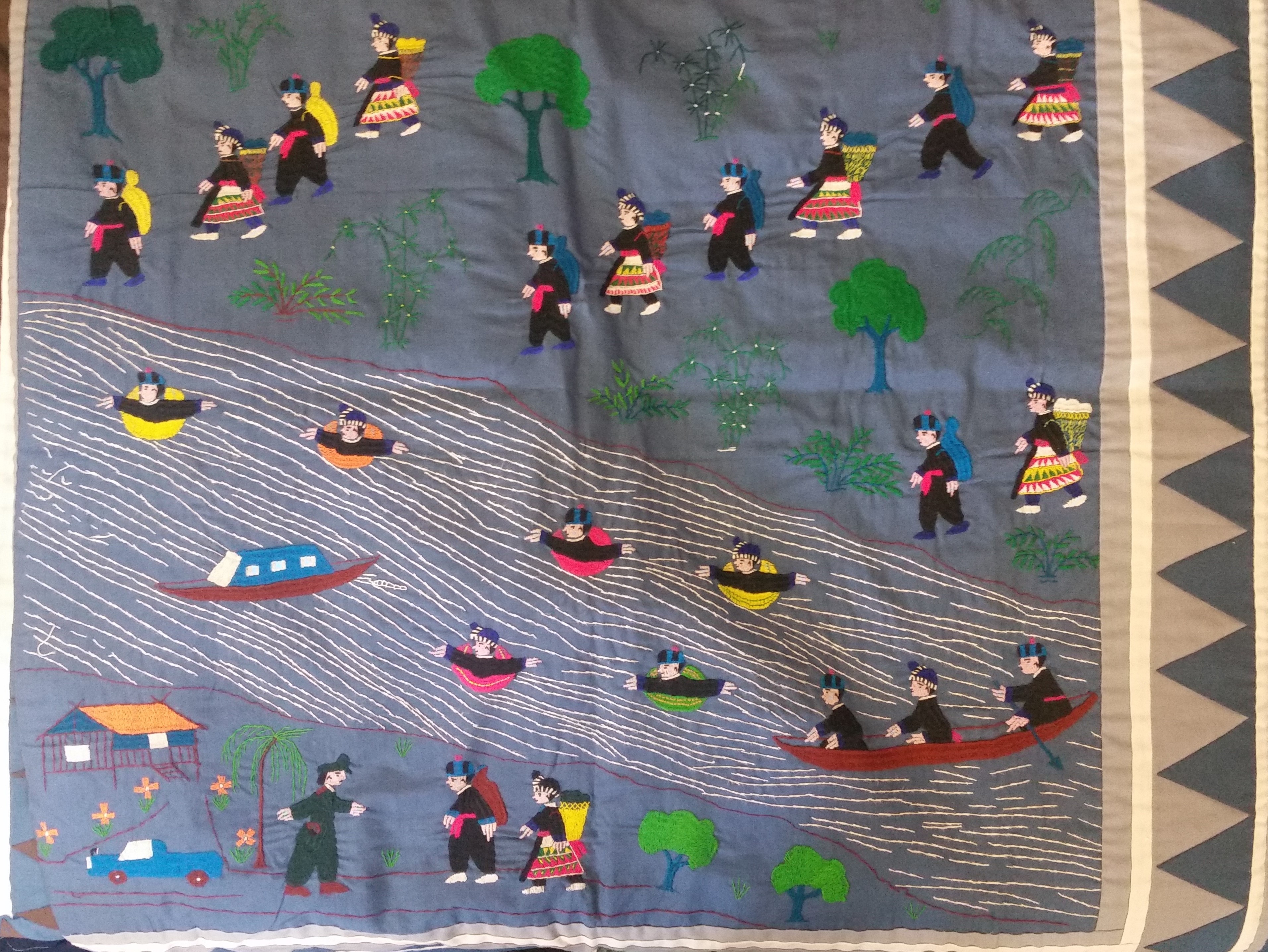
The object we studied was a story cloth made by a Hmong woman detailing the Hmong leaving Laos and entering Thailand. It was made from different layers and types of cloth and was embroidered, likely using a template to do so. It is very good condition, with only a few loose threads. Karen James donated it to the East Side Freedom Library according to their records, and she received it after assisting in the resettlement of a Hmong family in North Carolina, a family which eventually would move to the Midwest. It was made by hand in 2007. It is difficult to know if it was something the family made for themselves and then gifted, or if it was always made to be a gift to Karen James for her help.
It specifically details the Hmong people, starting at the top of the cloth, coming down from the mountains, bringing with them few possessions, and crossing the Mekong River into Thailand. There, they meet a Thai soldier. It represents primarily a series of events, but also details places, like the mountains and the rivers, and speaks to people as a unit rather than any individual. Most of the figures repeat in the sense that there is no unique clothing embroidered on the people in the cloth, further showing that no individual is emphasized here. Along with the people and the river, there is vegetation, but beside that, few other sewn objects until they cross the river. It is around 80×80 cm and was likely made to be a cultural history and reminder of the events the Hmong people went through while leaving Laos as refugees. Perhaps this is an attempt to preserve Hmong culture while immigrating to other nations.
I think the object provides an interesting base to look further into when trying to understand the story of the Hmong people. As mentioned it is very group oriented and portrays a collective story, rather than an individual one. It would be interesting to talk to the woman who made it and learn more about her thoughts about both making it and her, or her family’s, individual experience as refugees.
It is interesting because unlike other story cloths, it portrays very little violence and a much smaller variety of figures. In another story cloth, there are chickens and cows, as well as more objects such as kettles, sewn into the scene. Along with that, there are soldiers shooting and killing people, airplanes dropping bombs, and other such examples of violence. There also in no figures waiting in Thailand. I would be curious to know what made the woman who created the two story cloths to choose such different designs, and what each shows in regards to the story of the Hmong people and they way they view it. If the primarily story cloth was always meant to be a gift, perhaps the embroiders didn’t want it to be violent and more graphic? They do possess similar styles though, both having an almost identical border and incredibly similar figures and clothing styles.
What is really interesting about the cloth is the way time is portrayed. While there is an order to the events, top to bottom, because they are all presented at once it makes it seem as though the story is continuous or ongoing. From top to bottom, the Hmong start in the mountains, come down through the valley, and cross the river into Thailand. Some people are crossing the river while others are coming down from the mountain, but you know they too will eventually cross the river. These story clothes are sewn by the Hmong, detailing their own story, so they posses much of the agency in the way they are portrayed. In this case, because they are sewn almost exclusively by women, women serve as the protector and teller of their story.
Both the Winter Counts and the story clothes both uses images to depict events, and they do so to serve different, and similar, ends. They both are a chronicling of a people’s history. The Winter Count is a year by year account though, depicting many events through a singular image. In contract, the story cloth is a singular event told through series of much smaller events that all describe the larger one. Both work to preserve a history for a group of people though. While in different formats, written versus visual, the chronicles the Bede wrote and the story cloth also work to preserve and create a collective history of a people, the English and the Hmong respectively.